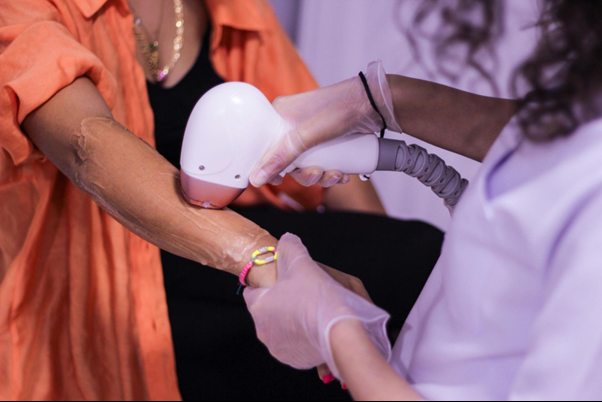When it comes to removing body hair for good, the two most popular options are electrolysis and laser hair removal.
Both treatments reduce hair growth, but they work in different ways and come with their own pros and cons. In this article, we tried to break down everything you need to know to decide which method is the right choice for you. Let's get to it.
What Are Electrolysis and Laser Hair Removal?
Electrolysis has been around for over a century. It uses a very thin needle that is inserted into each hair follicle. A mild electric current is applied to destroy the follicle at the root, so hair won't grow back. Each hair follicle is treated individually, making electrolysis a precise and long process.
Laser hair removal, on the other hand, is a newer technology that uses laser light. When the laser targets the hairs, it heats the hair follicles and damages them enough to slow down or stop hair growth. Unlike electrolysis, which treats each follicle individually, the laser can cover more follicles at once, making it a faster process.

Key Differences: What Sets Them Apart?
The biggest difference is in the permanence. Electrolysis is the only FDA-approved method that's known to be permanent for hair removal. Laser hair removal is often marketed as permanent, but it's more of a long-term solution, as some hair may eventually grow back (though it's usually thinner and finer).
Laser hair removal is generally faster. Electrolysis takes more time to complete because each follicle needs to be treated one by one.
In terms of pain, electrolysis can be a bit more uncomfortable for people because each follicle is zapped individually. Laser hair removal may cause some warmth, but it's generally more bearable.
Electrolysis works for all skin types. Laser hair removal, however, is more effective for people with fair skin and dark hair because the laser targets pigment. Advances in laser technology have made it safer for darker skin tones, but it's still less effective for very light or gray hair, as there's not enough pigment for the laser to treat.
Electrolysis: Pros and Cons
Let's break down the benefits and downsides of electrolysis.
Pros:
- Permanent results: Once the follicle is destroyed, it's gone for good, and you don't have to worry about hair growth.
- Works on any hair color: Because electrolysis doesn't rely on pigment, it's effective on light, gray, or even red hair.
- Suitable different skin types: Electrolysis works for every skin tone and type, so it's safe for everyone.
Cons:
- Time-consuming: Treating each follicle individually makes the process long, particularly for larger areas.
- More painful: Compared to laser hair removal, It can be more painful.
- Higher cost: Because it requires more time, electrolysis can end up costing more.

Laser Hair Removal: Pros and Cons
Now let's talk about laser hair removal's pros and cons.
Pros
- It's faster: The laser's ability to treat multiple follicles at once makes it much faster for big areas like your back or legs.
- Long-term hair reduction: While not fully permanent, laser hair removal reduces hair for a long period of time.
- Less discomfort: Compared to electrolysis, laser treatment is less painful for most people, although some might still feel a bit of discomfort.
Cons
- Not effective on all hair colors: Light, red, and gray hair are harder for the laser to treat effectively.
- Not ideal for all skin tones: Some laser systems aren't safe or as effective on darker skin tones, though newer lasers have expanded options.
- Maintenance treatments may be needed: Over time, some hair may return, so maintenance sessions might be necessary.
How Many Sessions Will You Need?
Electrolysis often requires 15-30 sessions per area, depending on hair thickness and your individual growth patterns. Each session lasts from around fifteen minutes to an hour, depending on what area you want to treat. Because electrolysis works on each follicle individually, results can be gradual.
Laser hair removal typically requires around 6-8 sessions for initial hair reduction, though some people may need more. The treatments are usually spaced about 4-6 weeks apart. Since laser treatment covers more in less time, you'll see quicker results compared to electrolysis.

Which One is More Affordable?
Both treatments can add up over time, but the cost will vary based on the area treated and the number of sessions.
Electrolysis hair removal costs around $30–$100 per session, but with more sessions needed, the total cost can increase. Laser hair removal ranges from $200–$400 per session, but fewer sessions are generally required.
If you're treating a small area (like your upper lip), electrolysis might be more affordable. But for large areas like the back or legs, laser hair removal is often the cheaper choice when considering the number of sessions you'll need.
Side Effects and Risks
Side affects you can experience with electrolysis include redness, swelling, and, in rare cases, some scarring or pigmentation changes, especially for darker skin tones.
As for laser hair removal, you can experience temporary redness and swelling, and there's a small risk of burns or pigmentation issues. Newer laser technology has reduced these risks significantly.

How to Choose What's Best for You?
Here are some factors to consider when deciding which method might be the best option for you:
- Skin tone and hair color: If you have light or gray hair, electrolysis might be a better choice. For those with fair skin and dark hair, laser hair removal could be a quick and effective option.
- Area of the body: For small areas like the upper lip or chin, electrolysis might be the best fit. For larger areas like the back or legs, laser hair removal might be faster.
- Pain tolerance: If you have a low pain tolerance, laser hair removal might feel more comfortable for you. However, some clinics do offer numbing options for electrolysis to make the experience easier.
- Budget: For large areas, laser hair removal is often more affordable. For smaller areas, both methods could be similarly priced, depending on the number of sessions you're going to need.
Overall, electrolysis is a good choice if you really want a permanent solution, have light hair, more patience, and a stronger pain tolerance.
Laser hair is a good option for treating larger areas like your legs and back if you don't mind going back for extra treatments.
Aftercare Tips
Regardless of the treatment you choose, following some basic aftercare can help you see the best possible results. Here are some things to keep in mind:
- Avoid sun exposure: Both laser and electrolysis can make your skin sensitive to sunlight. Try to stay out of direct sunlight and use plenty of sunscreen.
- Avoid scrubbing or harsh products: Use gentle skincare around the treated area for a few days to avoid irritation.
- Moisturize: Keeping your skin hydrated can reduce redness and help it heal more quickly.
- Avoid heat and sweating: Skip hot showers, saunas, and intense workouts right after treatment to prevent irritation.

Final Thoughts
There you have it, guys. That would be it for today's article. We've explored the pros and cons of both treatments, and it all comes down to your needs and preferences.
Both electrolysis and laser hair removal can give you smoother skin and help you stop worrying about constantly having to shave or wax.
Just think about your skin type, budget, and the results you want, and you can find the best method for you. We wish you luck on your journey.






